Revealing Kunming’s (China) Historical Urban Planning Policies Through Local Climate Zones
Abstract
1. Introduction
2. Materials and Methods
2.1. Study Area
2.2. Background on LCZ Mapping
2.3. Landsat Images
2.4. ROI and Training Areas
2.5. Classification Procedure and Its Adaptations
- A first adaptation is applied on the first condition of the WUDAPT protocol, where training areas should be homogeneous polygons with a minimum surface area of 1 km, because smaller surface areas would not be large enough to establish a local climate zone [32]. Since Kunming is characterised by heterogeneous areas, training areas of at least 1 km were difficult to find, so many smaller, homogeneous areas were selected.
- The second adaption takes neighbourhood information into account. This is not included in the original WUDAPT method causing loss of spectral variability due to the resampling of Landsat images to a 100 m resolution. Because of this, a contextual classifier was used that uses information from neighbouring 30 m pixels through a moving window [34]. This is a way to include horizontal heterogeneity. Multiple moving windows with different kernel sizes were used in order to select the most appropriate moving window per year (5 × 5, 7 × 7, 9 × 9 and 11 × 11 pixels, as was done in Verdonck et al. (2017) [34]).
- A third adaptation concerns the accuracy assessment. For each kernel size, 10 random forest classifications were performed. These runs are evaluated by assessing the map accuracies on the pixels of an independent validation polygon set, using an error matrix. Independent validation polygons are selected on randomly selected pixels from training areas, in order to avoid a positive bias of neighbouring training and validation samples [34]. The error matrix computes the overall accuracy (OA) and provides an estimation of the accuracy of the classification result. The OA is the division of the correctly allocated validation pixels by the total amount of validation pixels. In addition, F1-scores are computed, which are the weighted averages of the user (UA) and producer accuracies (PA). The UA gives an idea about how often the LCZ on the map is actually the LCZ in real life, while the PA is the probability that a certain LCZ in real life is correctly classified. The class-wise F1-score for class i is calculated as following [34,55,56,57]. In order to assess the robustness of the different classification methods, standard deviations (SD) on the OA and F1 are provided as well (see Table A1).
3. Results
3.1. LCZ Maps: General Description and Accuracy
3.2. LCZ Changes between 2005 and 2017
4. Discussion
4.1. Period between 2005 and 2011
4.2. Period between 2011 and 2017
4.3. Implications of Land-Cover Changes
5. Conclusions
Author Contributions
Funding
Acknowledgments
Conflicts of Interest
Appendix A
| 5 × 5 | 7 × 7 | 9 × 9 | 11 × 11 | |||
|---|---|---|---|---|---|---|
| 2015 | OA (%) | 96.9 ± 0.2 | 97.4 ± 0.1 | 97.7 ± 0.1 | 97.3 ± 0.1 | |
| F1 Measure (%) | LCZ 2 Compact mid-rise | 73.3 ± 2.2 | 75.6 ± 1.8 | 79.0 ± 2.0 | 74.6 ± 1.5 | |
| LCZ 3 Compact low-rise | 47.2 ± 2.9 | 47.6 ± 2.8 | 48.3 ± 4.1 | 40.2 ± 5.3 | ||
| LCZ 4 Open high-rise | 63.1 ± 2.0 | 62.9 ± 2.2 | 61.1 ± 2.1 | 56.4 ± 2.4 | ||
| LCZ 5 Open mid-rise | 83.9 ± 1.7 | 63.9 ± 3.8 | 67.4 ± 2.1 | 72.4 ± 4.3 | ||
| LCZ 6 Open low-rise | 88.3 ± 1.2 | 85.1 ± 1.6 | 85.7 ± 2.7 | 81.4 ± 2.1 | ||
| LCZ A Dense trees | 98.9 ± 0.1 | 99.3 ± 0.0 | 99.4 ± 0.1 | 99.5 ± 0.0 | ||
| LCZ B Scattered trees | 74.3 ± 2.5 | 75.8 ± 2.8 | 80.5 ± 2.1 | 74.3 ± 3.6 | ||
| LCZ C Bush, scrub | 60.3 ± 1.2 | 62.3 ± 0.8 | 67.0 ± 3.4 | 66.2 ± 5.2 | ||
| LCZ D Low plants | 64.7 ± 2.8 | 67.1 ± 3.3 | 75.1 ± 2.5 | 73.4 ± 1.6 | ||
| LCZ G Water | 99.9 ± 0.0 | 99.9 ± 0.0 | 99.9 ± 0.0 | 99.9 ± 0.0 | ||
| LCZ H Agricultural greenhouse | 92.4 ± 0.9 | 93.0 ± 1.0 | 95.7 ± 0.7 | 94.6 ± 0.4 | ||
| 2011 | OA (%) | 96.8 ± 0.1 | 96.7 ± 0.1 | 96.5 ± 0.1 | 96.3 ± 0.2 | |
| F1 Measure (%) | LCZ 2 Compact mid-rise | 73.2 ± 1.0 | 77.6 ± 0.7 | 78.0 ± 0.8 | 77.3 ± 0.9 | |
| LCZ 3 Compact low-rise | 54.5 ± 2.5 | 55.8 ± 1.2 | 54.3 ± 1.8 | 51.4 ± 2.2 | ||
| LCZ 4 Open high-rise | 75.4 ± 0.9 | 77.2 ± 0.7 | 76.9 ± 1.0 | 74.8 ± 1.3 | ||
| LCZ 5 Open mid-rise | 57.6 ± 0.7 | 56.4 ± 1.1 | 56.1 ± 1.5 | 57.9 ± 1.4 | ||
| LCZ 6 Open low-rise | 60.8 ± 2.4 | 56.8 ± 1.7 | 56.2 ± 1.6 | 55.2 ± 1.8 | ||
| LCZ 8 Large low-rise | 89.0 ± 1.4 | 91.4 ± 0.4 | 92.3 ± 0.6 | 92.1 ± 0.8 | ||
| LCZ 10 Heavy industry | 68.8 ± 0.4 | 60 ± 0.2 | 58.0 ± 0.5 | 56.3 ± 0.8 | ||
| LCZ A Dense trees | 98.9 ± 0.2 | 99.4 ± 0.1 | 99.6 ± 0.2 | 99.5 ± 0.2 | ||
| LCZ B Scattered trees | 60.4 ± 1.4 | 68.2 ± 2.0 | 65.4 ± 1.8 | 63.3 ± 1.9 | ||
| LCZ C Bush, scrub | 70.0 ± 3.3 | 72.5 ± 1.4 | 71.8 ± 2.5 | 70.9 ± 3.0 | ||
| LCZ D Low plants | 86.6 ± 2.2 | 83.2 ± 2.8 | 82.0 ± 2.8 | 79.0 ± 3.2 | ||
| LCZ G Water | 100.0 ± 0.0 | 100.0 ± 0.0 | 100.0 ± 0.0 | 100.0 ± 0.0 | ||
| LCZ H Agricultural greenhouse | 96.9 ± 0.7 | 95.5 ± 0.9 | 96.7 ± 0.8 | 95.3 ± 1.1 | ||
| 2017 | OA (%) | 95.8 ± 0.1 | 95.9 ± 0.1 | 95.7 ± 0.1 | 95.4 ± 0.2 | |
| F1 Measure (%) | LCZ 1 Compact high-rise | 74.8 ± 1.2 | 78.0 ± 0.8 | 78.0 ± 0.7 | 71.8 ± 2.2 | |
| LCZ 2 Compact mid-rise | 86.6 ± 0.4 | 84.4 ± 0.6 | 84.1 ± 0.5 | 83.0 ± 0.9 | ||
| LCZ 3 Compact low-rise | 61.3 ± 0.8 | 67.8 ± 2.3 | 50.5 ± 3.1 | 56.9 ± 4.0 | ||
| LCZ 4 Open high-rise | 77.4 ± 0.3 | 76.7 ± 0.8 | 74.4 ± 0.6 | 69.9 ± 0.7 | ||
| LCZ 5 Open mid-rise | 45.1 ± 1.0 | 45.3 ± 2.5 | 48.1 ± 2.1 | 43.0 ± 3.6 | ||
| LCZ 6 Open low-rise | 56.7 ± 1.3 | 50.6 ± 1.5 | 49.9 ± 1.8 | 49.1 ± 1.2 | ||
| LCZ 8 Large low-rise | 90.7 ± 0.9 | 93.8 ± 0.4 | 92.4 ± 0.6 | 88.8 ± 0.8 | ||
| LCZ 10 Heavy industry | 75.8 ± 3.5 | 63.2 ± 1.2 | 63.7 ± 9.4 | 50.7 ± 5.1 | ||
| LCZ A Dense trees | 97.3 ± 0.2 | 98.2 ± 0.3 | 97.0 ± 0.5 | 96.0 ± 0.4 | ||
| LCZ B Scattered trees | 60.8 ± 1.9 | 61.6 ± 4.5 | 52.8 ± 4.6 | 46.7 ± 4.8 | ||
| LCZ C Bush, scrub | 80.9 ± 4.5 | 74.2 ± 3.8 | 60.6 ± 4.1 | 74.1 ± 4.9 | ||
| LCZ D Low plants | 85.6 ± 2.6 | 83.5 ± 1.3 | 78.0 ± 2.4 | 72.1 ± 3.2 | ||
| LCZ G Water | 100.0 ± 0.0 | 100.0 ± 0.0 | 100.0 ± 0.0 | 100.0 ± 0.0 | ||
| LCZ H Agricultural greenhouse | 96.7 ± 0.4 | 96.3 ± 0.3 | 96.9 ± 0.2 | 96.4 ± 0.1 |
References
- Grimm, N.B.; Faeth, S.H.; Golubiewski, N.E.; Redman, C.L.; Wu, J.; Bai, X.; Briggs, J.M. Global Change and the Ecology of Cities. Science 2008, 319, 756–760. [Google Scholar] [CrossRef] [PubMed]
- Wu, J.; Wei-Ning, X.; Zhao, J. Urban ecology in China: Historical developments and future directions. Landsc. Urban Plan. 2014, 125, 222–233. [Google Scholar] [CrossRef]
- Sun, Y.; Zhang, X.; Ren, G.; Zwiers, F.W.; Hu, T. Contribution of urbanization to warming in China. Nat. Clim. Chang. 2016, 6, 706. [Google Scholar] [CrossRef]
- Chow, G.C. Economic reform and growth in China. Ann. Econ. Financ. 2004, 152, 127–152. [Google Scholar]
- Luo, J.; Wei, Y.H.D. Modeling spatial variations of urban growth patterns in Chinese cities: The case of Nanjing. Landsc. Urban Plan. 2009, 91, 51–64. [Google Scholar] [CrossRef]
- Zhang, Q.; Su, S. Determinants of urban expansion and their relative importance: A comparative analysis of 30 major metropolitans in China. Habitat Int. 2016, 58, 89–107. [Google Scholar] [CrossRef]
- Gong, P.; Liang, S.; Carlton, E.J.; Jiang, Q.; Wu, J.; Wang, L.; Remais, J.V. Urbanisation and health in China. Lancet 2012, 379, 843–852. [Google Scholar] [CrossRef]
- Wang, Q.; Xu, Q.; Hong, L.; Peng, S. Extraction and Spatial-Temporal Analysis of Impervious Surfaces Expansion in Dianchi Lake Basin. In Proceedings of the 2018 26th International Conference on Geoinformatics (GEOINFORMATICS 2018), Kunming, China, 28–30 June 2018; Hu, S., Ye, X., Yang, K., Fan, H., Eds.; SuperMap Software Co Ltd.: Beijing, China; Beijing PIESAT Informat Technol Co Ltd.: Beijing, China; Yunnan Normal Univ: Kunming, China, 2018. [Google Scholar]
- Liu, M.; Zhang, Z.; Zhang, H.; Yang, M.; Song, D.; Ou, X. Spatial-temporal monitoring of urban growth: A case in Kunming, southwest China. Commun. Comput. Inf. Sci. 2016, 116–127. [Google Scholar] [CrossRef]
- Li, G.; Sun, S.; Fang, C. The varying driving forces of urban expansion in China: Insights from a spatial-temporal analysis. Landsc. Urban Plan. 2018, 174, 63–77. [Google Scholar] [CrossRef]
- Zhang, Z.; Wang, B.; Buyantuev, A.; He, X.; Gao, W.; Wang, Y.; Dawazhaxi; Yang, Z. Urban agglomeration of Kunming and Yuxi cities in Yunnan, China: the relative importance of government policy drivers and environmental constraints. Landsc. Ecol. 2019, 34, 663–679. [Google Scholar] [CrossRef]
- Qiyan, W.; Jianquan, C.; Dan, L.; Li, H.; Yuhong, Y. Kunming: A Regional International Mega City in Southwest China. In Urban Development Challenges, Risks and Resilience in Asian Mega Cities; Singh, R., Ed.; Springer: Tokyo, Japan, 2015; pp. 323–347. [Google Scholar]
- National Bureau of Statistics of China. China Statistical Yearbook; Chinese Statistical Bureau: Beijing, China, 2004; p. 62791819. Available online: http://www.stats.gov.cn/tjsj/ndsj/2007/indexee.htm (accessed on 15 June 2019).
- Fang, C.; Yu, D. Urban agglomeration: An evolving concept of an emerging phenomenon. Landsc. Urban Plan. 2017, 162, 126–136. [Google Scholar] [CrossRef]
- Oke, T.R.; Mills, G.; Christen, A.; Voogt, J.A. Urban Climates; Cambridge University Press: Cambridge, UK, 2017; pp. 1–525. [Google Scholar] [CrossRef]
- Singh, S.K.; Srivastava, P.K.; Gupta, M.; Thakur, J.K.; Mukherjee, S. Appraisal of land use/land cover of mangrove forest ecosystem using support vector machine. Environ. Earth Sci. 2014, 71, 2245–2255. [Google Scholar] [CrossRef]
- Yang, X.; Lo, C.P. Using a time series of satellite imagery to detect land use and land cover changes in the Atlanta, Georgia metropolitan area. Int. J. Remote Sens. 2002, 23, 1775–1798. [Google Scholar] [CrossRef]
- Yan, Z.W.; Wang, J.; Xia, J.J.; Feng, J.M. Review of recent studies of the climatic effects of urbanization in China. Adv. Clim. Chang. Res. 2016, 7, 154–168. [Google Scholar] [CrossRef]
- Wai PoTse, J.; ShingYeung, P.; Chi-HungFung, J.; Ren, C.; Wang, R.; Mau-Fong, M.; Cai, M. Investigation of the meteorological effects of urbanization in recent decades: A case study of major cities in Pearl River Delta. Urban Clim. 2018, 26, 174–187. [Google Scholar]
- Li, F. Physical activity and health in the presence of China’s economic growth: Meeting the public health challenges of the aging population. J. Sport Health Sci. 2016, 5, 258–269. [Google Scholar] [CrossRef] [PubMed]
- Zhang, B.; Liu, W. Planning history research in China: Past, present, and future. Plan. Perspect. 2018, 33, 113–124. [Google Scholar] [CrossRef]
- Cui, L.; Shi, J. Urbanization and its environmental effects in Shanghai, China. Urban Clim. 2012, 2, 1–15. [Google Scholar] [CrossRef]
- Xu, L.; Cui, S.; Tang, J.; Nguyen, M.; Liu, J.; Zhao, Y. Assessing the adaptive capacity of urban form to climate stress: a case study on an urban heat island. Environ. Res. Lett. 2019, 14, 044013. [Google Scholar] [CrossRef]
- Eliasson, I.; Knez, I.; Westerberg, U.; Thorsson, S.; Lindberg, F. Climate and behaviour in a Nordic city. Landsc. Urban Plan. 2007, 82, 72–84. [Google Scholar] [CrossRef]
- Coutts, A.M.; Daly, E.; Beringer, J.; Tapper, N.J. Assessing practical measures to reduce urban heat: Green and cool roofs. Build. Environ. 2013, 70, 266–276. [Google Scholar] [CrossRef]
- Acuto, M. Global science for city policy. Science 2018, 359, 165–166. [Google Scholar] [CrossRef] [PubMed]
- Creutzig, F.; Lohrey, S.; Bai, X.; Baklanov, A.; Dawson, R.; Dhakal, S.; Lamb, W.F.; McPhearson, T.; Minx, J.; Munoz, E.; et al. Upscaling urban data science for global climate solutions. Glob. Sustain. 2019, 2. [Google Scholar] [CrossRef]
- Ching, J.; Mills, G.; Bechtel, B.; See, L.; Feddema, J.; Wang, X.; Ren, C.; Brorousse, O.; Martilli, A.; Neophytou, M.; et al. WUDAPT: An urban weather, climate, and environmental modeling infrastructure for the anthropocene. Bull. Am. Meteorol. Soc. 2018, 99, 1907–1924. [Google Scholar] [CrossRef]
- Stewart, I.D.; Oke, T.R. Local climate zones for urban temperature studies. Bull. Am. Meteorol. Soc. 2012, 93, 1879–1900. [Google Scholar] [CrossRef]
- Middel, A.; Häb, K.; Brazel, A.J.; Martin, C.A.; Guhathakurta, S. Impact of urban form and design on mid-afternoon microclimate in Phoenix Local Climate Zones. Landsc. Urban Plan. 2014, 122, 16–28. [Google Scholar] [CrossRef]
- Wang, R.; Cai, M.; Ren, C.; Bechtel, B.; Xu, Y.; Ng, E. Detecting multi-temporal land cover change and land surface temperature in Pearl River Delta by adopting local climate zone. Urban Clim. 2019, 28, 100455. [Google Scholar] [CrossRef]
- Bechtel, B.; Alexander, P.; Böhner, J.; Ching, J.; Conrad, O.; Feddema, J.; Mills, G.; See, L.; Stewart, I. Mapping Local Climate Zones for a Worldwide Database of the Form and Function of Cities. ISPRS Int. J. Geo-Inf. 2015, 4, 199–219. [Google Scholar] [CrossRef]
- Bechtel, B.; Demuzere, M.; Mills, G. SUHI analysis using Local Climate Zones—A comparison of 50 cities. Urban Clim. 2019, 28, 100451. [Google Scholar] [CrossRef]
- Verdonck, M.L.; Okujeni, A.; Van der Linden, S.; Demuzere, M.; De Wulf, R.; Van Coillie, F. Influence of neighbourhood information on ‘Local Climate Zone’ mapping in heterogeneous cities. Int. J. Appl. Earth Obs. Geoinf. 2017, 62, 102–113. [Google Scholar] [CrossRef]
- Qiu, C.; Schmitt, M.; Mou, L.; Ghamisi, P.; Zhu, X.X. Feature Importance Analysis for Local Climate Zone Classification Using a Residual Convolutional Neural Network with Multi-Source Datasets. Remote Sens. 2018, 10, 1572. [Google Scholar] [CrossRef]
- Qiu, C.; Schmitt, M.; Ghamisi, P.; Mou, L.; Zhu, X.X. Feature importance analysis of Sentinel-2 imagery for large-scale urban local climate zone classification. In Proceedings of the IGARSS 2018—2018 IEEE International Geoscience and Remote Sensing Symposium, Valencia, Spain, 22–27 July 2018; pp. 4681–4684. [Google Scholar]
- Hu, J.; Ghamisi, P.; Zhu, X.X. Feature Extraction and Selection of Sentinel-1 Dual-Pol Data for Global-Scale Local Climate Zone Classification. ISPRS Int. J. Geo-Inf. 2018, 7, 379. [Google Scholar] [CrossRef]
- Hu, J.; Zhu, X.X. Exploring Sentinel-1 data for local climate zone classification. In Proceedings of the IGARSS 2018—2018 IEEE International Geoscience and Remote Sensing Symposium, Valencia, Spain, 22–27 July 2018; pp. 4677–4680. [Google Scholar]
- Demuzere, M.; Bechtel, B.; Mills, G. Global transferability of local climate zone models. Urban Clim. 2019, 27, 46–63. [Google Scholar] [CrossRef]
- Demuzere, M.; Bechtel, B.; Middel, A.; Mills, G. Mapping Europe into local climate zones. PLoS ONE 2019, 14, e0214474. [Google Scholar] [CrossRef] [PubMed]
- Bechtel, B.; Alexander, P.J.; Beck, C.; Böhner, J.; Brousse, O.; Ching, J.; Demuzere, M.; Fonte, C.; Gál, T.; Hidalgo, J.; et al. Generating WUDAPT Level 0 data—Current status of production and evaluation. Urban Clim. 2019, 27, 24–45. [Google Scholar] [CrossRef]
- Baklanov, A.; Grimmond, C.S.; Carlson, D.; Terblanche, D.; Tang, X.; Bouchet, V.; Lee, B.; Langendijk, G.; Kolli, R.K.; Hovsepyan, A. From urban meteorology, climate and environment research to integrated city services. Urban Clim. 2018, 23, 330–341. [Google Scholar] [CrossRef]
- Cai, M.; Ren, C.; Xu, Y.; Lau, K.K.L.; Wang, R. Investigating the relationship between local climate zone and land surface temperature using an improved WUDAPT methodology—A case study of Yangtze River Delta, China. Urban Clim. 2018, 24, 485–502. [Google Scholar] [CrossRef]
- Hidalgo, J.; Dumas, G.; Masson, V.; Petit, G.; Bechtel, B.; Bocher, E.; Foley, M.; Schoetter, R.; Mills, G. Comparison between local climate zones maps derived from administrative datasets and satellite observations. Urban Clim. 2019, 27, 64–89. [Google Scholar] [CrossRef]
- Maussion, F.; Tbridel; Schlump; Rothenberg, D. Fmaussion/Salem: v0.2.2; Zenodo: Geneva, Switzerland, 2018. [Google Scholar]
- Pachauri, R.K.; Allen, M.R.; Barros, V.R.; Broome, J.; Cramer, W.; Christ, R.; Church, J.A.; Clarke, L.; Dahe, Q.; Dasgupta, P.; et al. Climate Change 2014: Synthesis Report. Contribution of Working Groups I, II and III to the Fifth Assessment Report of the Intergovernmental Panel on Climate Change; EPIC3; IPCC: Geneva, Switzerland, 2014; p. 151. ISBN 978-92-9169-143-2. [Google Scholar]
- Geletič, J.; Lehnert, M.; Dobrovolný, P. Land surface temperature differences within local climate zones, Based on two central European cities. Remote Sens. 2016, 8, 788. [Google Scholar] [CrossRef]
- Scarano, M.; Sobrino, J.A. On the relationship between the sky view factor and the land surface temperature derived by Landsat-8 images in Bari, Italy. Int. J. Remote Sens. 2015, 36, 4820–4835. [Google Scholar] [CrossRef]
- Liu, S.; Qi, Z.; Li, X.; Yeh, A. Integration of Convolutional Neural Networks and Object-Based Post-Classification Refinement for Land Use and Land Cover Mapping with Optical and SAR Data. Remote Sens. 2019, 11, 690. [Google Scholar] [CrossRef]
- Simanjuntak, R.M.; Kuffer, M.; Reckien, D. Object-based image analysis to map local climate zones: The case of Bandung, Indonesia. Appl. Geogr. 2019, 106, 108–121. [Google Scholar] [CrossRef]
- Brousse, O.; Georganos, S.; Demuzere, M.; Vanhuysse, S.; Wouters, H.; Wolff, E.; Linard, C.; Van Lipzig, N.P.; Dujardin, S. Using Local Climate Zones in Sub-Saharan Africa to tackle urban health issues. Urban Clim. 2019, 27, 227–242. [Google Scholar] [CrossRef]
- Wang, C.; Middel, A.; Myint, S.W.; Kaplan, S.; Brazel, A.J.; Lukasczyk, J. Assessing local climate zones in arid cities: The case of Phoenix, Arizona and Las Vegas, Nevada. ISPRS J. Photogramm. Remote Sens. 2018, 141, 59–71. [Google Scholar] [CrossRef]
- Böhner, J.; Bock, M.; Wichmann, V.; Fischer, E.; Wehberg, J.; Conrad, O.; Bechtel, B.; Dietrich, H.; Gerlitz, L. System for Automated Geoscientific Analyses (SAGA) v. 2.1.4. Geosci. Model Dev. 2015, 8, 1991–2007. [Google Scholar] [CrossRef]
- Scaramuzza, P.; Micijevic, E.; Chander, G. SLC Gap-Filled Products Phase One Methodology. In Landsat Technical Notes; NASA: Washington, DC, USA, 2004; pp. 1–5. [Google Scholar]
- Sokolova, M.; Lapalme, G. A systematic analysis of performance measures for classification tasks. Inf. Process. Manag. 2009, 45, 427–437. [Google Scholar] [CrossRef]
- Bechtel, B.; Demuzere, M.; Sismanidis, P.; Fenner, D.; Brousse, O.; Beck, C.; Van Coillie, F.; Conrad, O.; Keramitsoglou, I.; Middel, A.; et al. Quality of Crowdsourced Data on Urban Morphology—The Human Influence Experiment (HUMINEX). Urban Sci. 2017, 1, 15. [Google Scholar] [CrossRef]
- Verdonck, M.L.; Demuzere, M.; Bechtel, B.; Beck, C.; Brousse, O.; Droste, A.; Fenner, D.; Leconte, F.; Van Coillie, F. The Human Influence Experiment (Part 2): Guidelines for Improved Mapping of Local Climate Zones Using a Supervised Classification. Urban Sci. 2019, 3, 27. [Google Scholar] [CrossRef]
- Wu, Q.; Cheng, J.; Liu, D.; Han, L.; Yang, Y. Kunming: A Regional International Mega City in Southwest China; Springer: Tokyo, Japan, 2014. [Google Scholar] [CrossRef]
- Haaland, C.; Van den Bosch, C.K. Challenges and Strategies for Urban Green-Space Planning in Cities Undergoing Densification: A Review; Elsevier: Amsterdam, The Netherlands, 2015. [Google Scholar] [CrossRef]
- The World Bank. Urban China: Toward Efficient, Inclusive, and Sustainable Urbanization; World Bank Publications: Washington, DC, USA, 2014; p. 111. [Google Scholar]
- Creutzig, F.; Baiocchi, G.; Bierkandt, R.; Pichler, P.P.; Seto, K.C. Global typology of urban energy use and potentials for an urbanization mitigation wedge. Proc. Natl. Acad. Sci. USA 2015, 112, 6283–6288. [Google Scholar] [CrossRef]
- Creutzig, F.; Agoston, P.; Minx, J.C.; Canadell, J.G.; Andrew, R.M.; Quéré, C.L.; Peters, G.P.; Sharifi, A.; Yamagata, Y.; Dhakal, S. Urban infrastructure choices structure climate solutions. Nat. Clim. Chang. 2016, 6, 1054. [Google Scholar] [CrossRef]
- Jian, H.; Pan, H.; Xiong, G.; Lin, X. The Impacts of Civil Airport layout to Yunnan Local Tourism Industry. Transp. Res. Procedia 2017, 25, 77–91. [Google Scholar] [CrossRef]
- Wang, R.; Tao, S.; Wang, W.; Liu, J.; Shen, H.; Shen, G.; Wang, B.; Liu, X.; Li, W.; Huang, Y.; et al. Black carbon emissions in China from 1949 to 2050. Environ. Sci. Technol. 2012, 46, 7595–7603. [Google Scholar] [CrossRef] [PubMed]
- Demuzere, M.; Orru, K.; Heidrich, O.; Olazabal, E.; Geneletti, D.; Orru, H.; Bhave, A.G.; Mittal, N.; Feliu, E.; Faehnle, M. Mitigating and adapting to climate change: Multi-functional and multi-scale assessment of green urban infrastructure. J. Environ. Manag. 2014, 146, 107–115. [Google Scholar] [CrossRef] [PubMed]
- Salmond, J.A.; Tadaki, M.; Vardoulakis, S.; Arbuthnott, K.; Coutts, A.; Demuzere, M.; Dirks, K.N.; Heaviside, C.; Lim, S.; MacIntyre, H.; et al. Health and climate related ecosystem services provided by street trees in the urban environment. Environ. Health 2016, 15, S36. [Google Scholar] [CrossRef] [PubMed]
- Armson, D.; Stringer, P.; Ennos, A.R. The effect of street trees and amenity grass on urban surface water runoff in Manchester, UK. Urban For. Urban Green. 2013, 12, 282–286. [Google Scholar] [CrossRef]
- McPherson, E.G.; Van Doorn, N.; De Goede, J. Structure, function and value of street trees in California, USA. Urban For. Urban Green. 2016, 17, 104–115. [Google Scholar] [CrossRef]
- Wang, X.; Yao, J.; Yu, S.; Miao, C.; Chen, W.; He, X. Street trees in a Chinese forest city: Structure, benefits and costs. Sustainability 2018, 10, 674. [Google Scholar] [CrossRef]
- Zölch, T.; Maderspacher, J.; Wamsler, C.; Pauleit, S. Using green infrastructure for urban climate-proofing: An evaluation of heat mitigation measures at the micro-scale. Urban For. Urban Green. 2016, 20, 305–316. [Google Scholar] [CrossRef]
- Meng, C. Mitigating the surface urban heat island: Mechanism study and sensitivity analysis. Asia-Pac. J. Atmos. Sci. 2017, 53, 327–338. [Google Scholar] [CrossRef]
- Ürge-Vorsatz, D.; Rosenzweig, C.; Dawson, R.J.; Sanchez Rodriguez, R.; Bai, X.; Barau, A.S.; Seto, K.C.; Dhakal, S. Locking in positive climate responses in cities. Nat. Clim. Chang. 2018, 8, 174–177. [Google Scholar] [CrossRef]
- Zhou, W.; Huang, G.; Cadenasso, M.L. Does spatial configuration matter? Understanding the effects of land cover pattern on land surface temperature in urban landscapes. Landsc. Urban Plan. 2011, 102, 54–63. [Google Scholar] [CrossRef]
- Zhao, C. Linking the local climate zones and land surface temperature to investigate the surface urban heat island, a case study of San Antonia, Texas, U.S. ISPRS Ann. Photogramm. Remote Sens. Spat. Inf. Sci. 2018, 4. [Google Scholar] [CrossRef]
- Alexander, P.J.; Mills, G. Local climate classification and Dublin’s urban heat island. Atmosphere 2014, 5, 755–774. [Google Scholar] [CrossRef]
- Stewart, I.D.; Oke, T.R.; Krayenhoff, E.S. Evaluation of the “local climate zone” scheme using temperature observations and model simulations. Int. J. Climatol. 2014, 34, 1062–1080. [Google Scholar] [CrossRef]
- Lehnert, M.; Geletič, J.; Husák, J.; Vysoudil, M. Urban field classification by “local climate zones” in a medium-sized Central European city: The case of Olomouc (Czech Republic). Theor. Appl. Climatol. 2015, 122, 531–541. [Google Scholar] [CrossRef]
- Fenner, D.; Meier, F.; Bechtel, B.; Otto, M.; Scherer, D. Intra and inter “local climate zone” variability of air temperature as observed by crowdsourced citizen weather stations in Berlin, Germany. Meteorol. Z. 2017, 26, 525–547. [Google Scholar] [CrossRef]
- Skarbit, N.; Stewart, I.D.; Unger, J.; Gál, T. Employing an urban meteorological network to monitor air temperature conditions in the ‘local climate zones’ of Szeged, Hungary. Int. J. Climatol. 2017, 37, 582–596. [Google Scholar] [CrossRef]
- Scally. Urban Re-Greening Effort to Include 37 New Kunming Parks; GoKunming: Kunming, China, 2017. [Google Scholar]
- Xiao, M.; Lin, Y.; Han, J.; Zhang, G. A review of green roof research and development in China. Renew. Sustain. Energy Rev. 2014, 40, 633–648. [Google Scholar] [CrossRef]
- Nace, T. China Shuts Down Tens of Thousands of Factories in Widespread Pollution Crackdown; Forbes: Jersey City, NJ, USA, 2017. [Google Scholar]
- Scally. How Bad Is Kunming’s Air? GoKunming: Kunming, China, 2013. [Google Scholar]
- Scally. River Diversion to Flush Pollution Out of Yunnan’s Dianchi Lake; GoKunming: Kunming, China, 2016. [Google Scholar]
- Verdonck, M.L.; Demuzere, M.; Hooyberghs, H.; Priem, F.; Van Coillie, F. Heat risk assessment for the Brussels capital region under different urban planning and greenhouse gas emission scenarios. J. Environ. Manag. 2019. accepted. [Google Scholar]
- Mora, C.; Dousset, B.; Caldwell, I.R.; Powell, F.E.; Geronimo, R.C.; Bielecki, C.R.; Counsell, C.W.; Dietrich, B.S.; Johnston, E.T.; Louis, L.V.; et al. Global risk of deadly heat. Nat. Clim. Chang. 2017, 7, 501. [Google Scholar] [CrossRef]
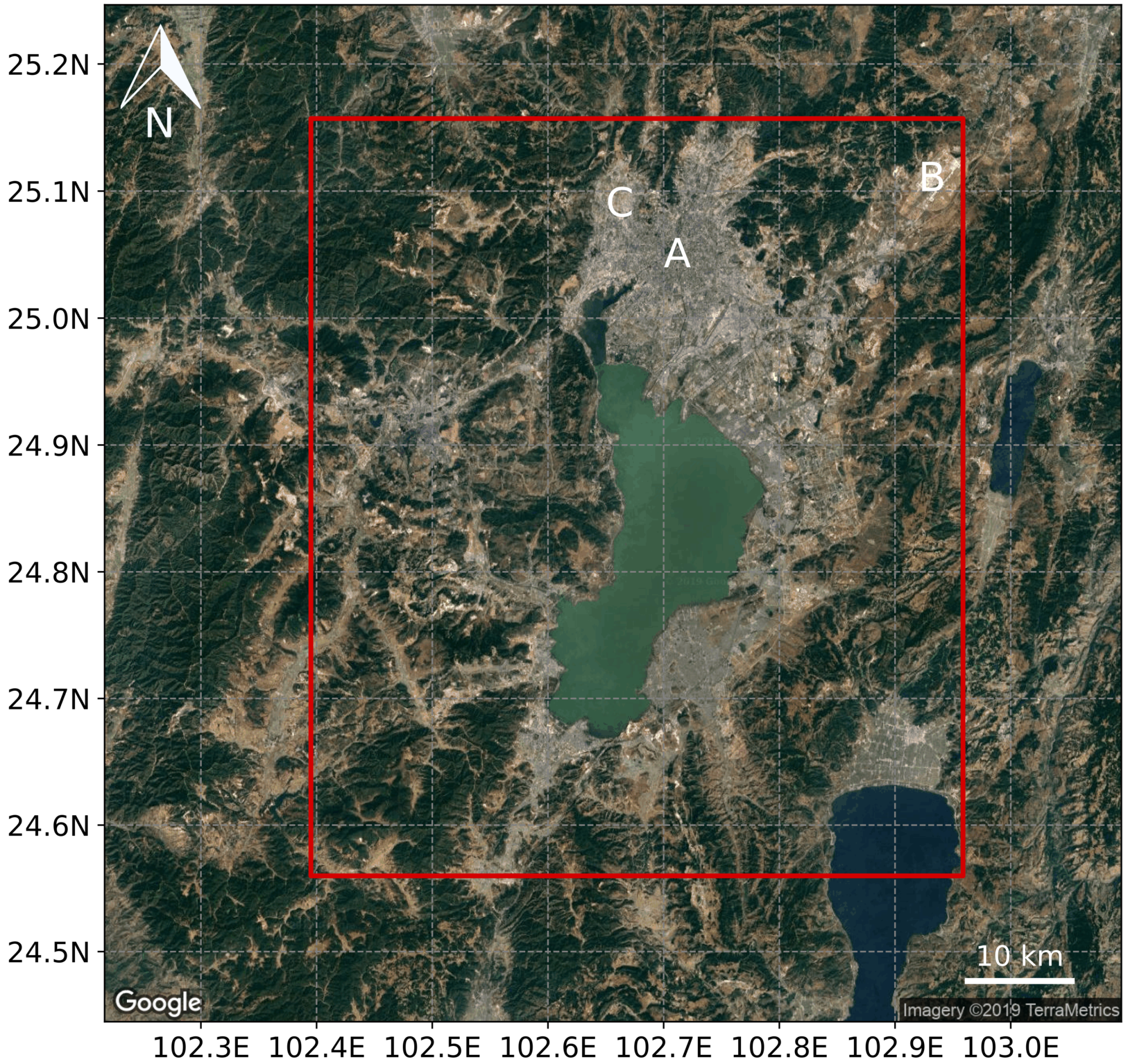
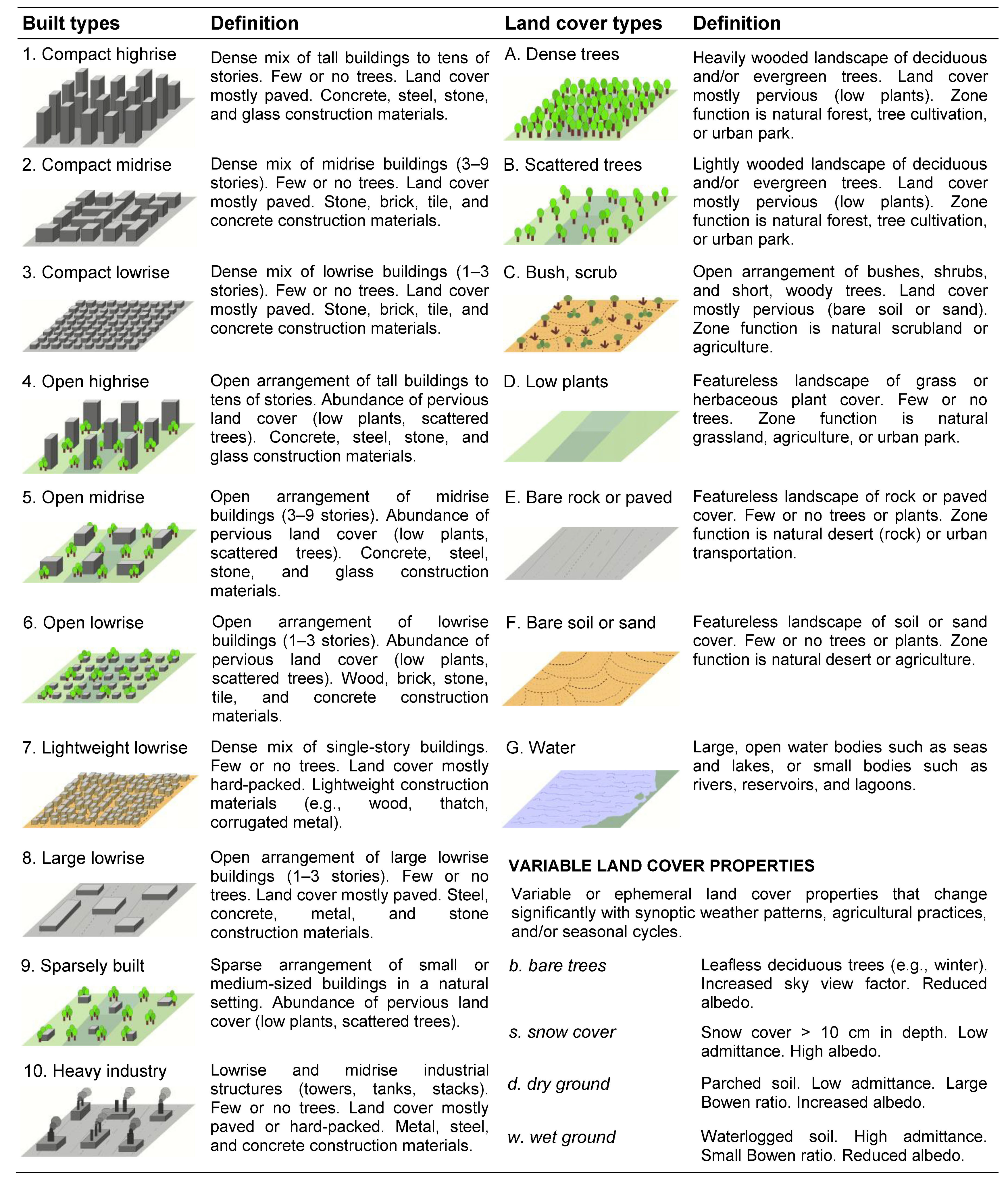
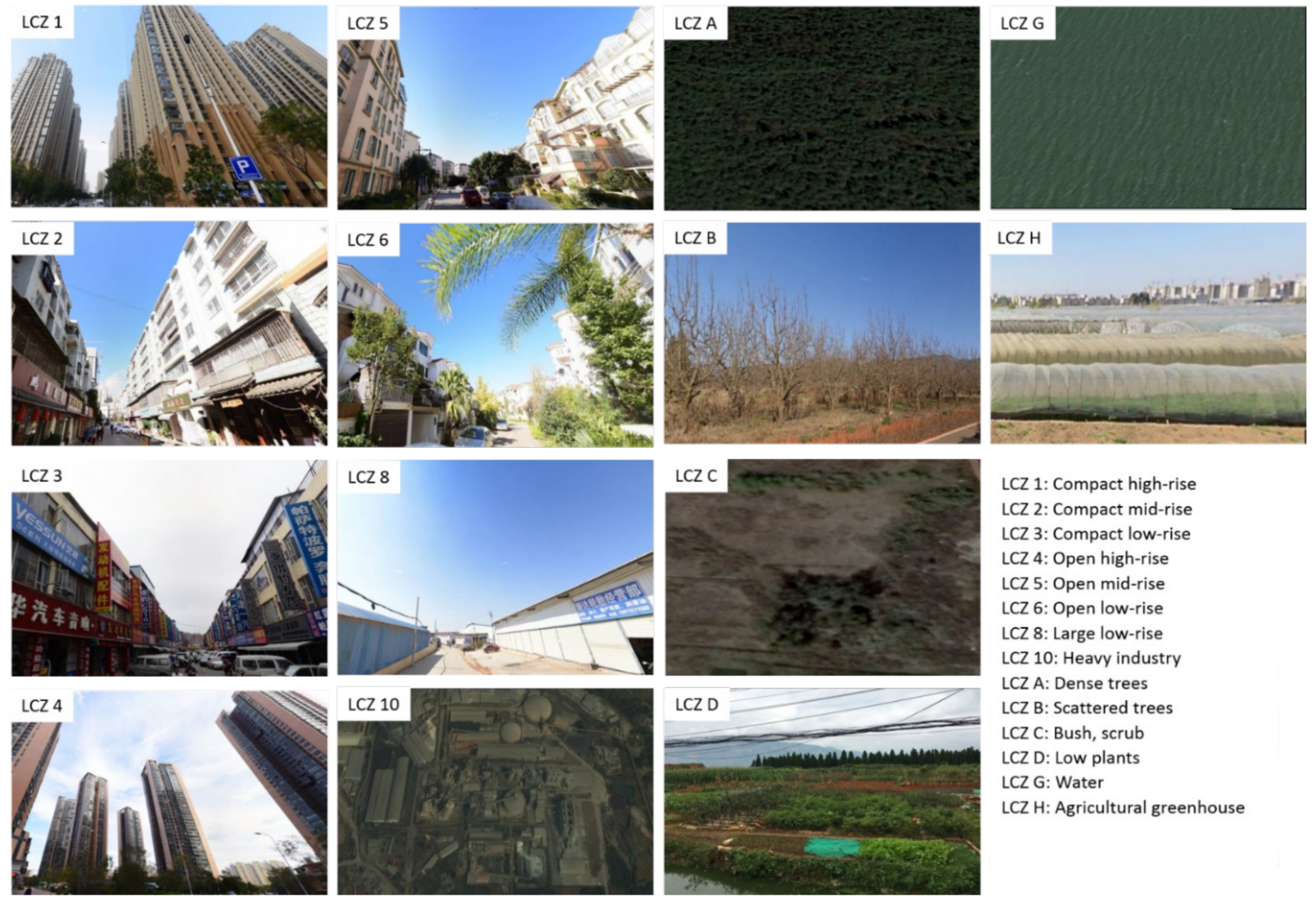
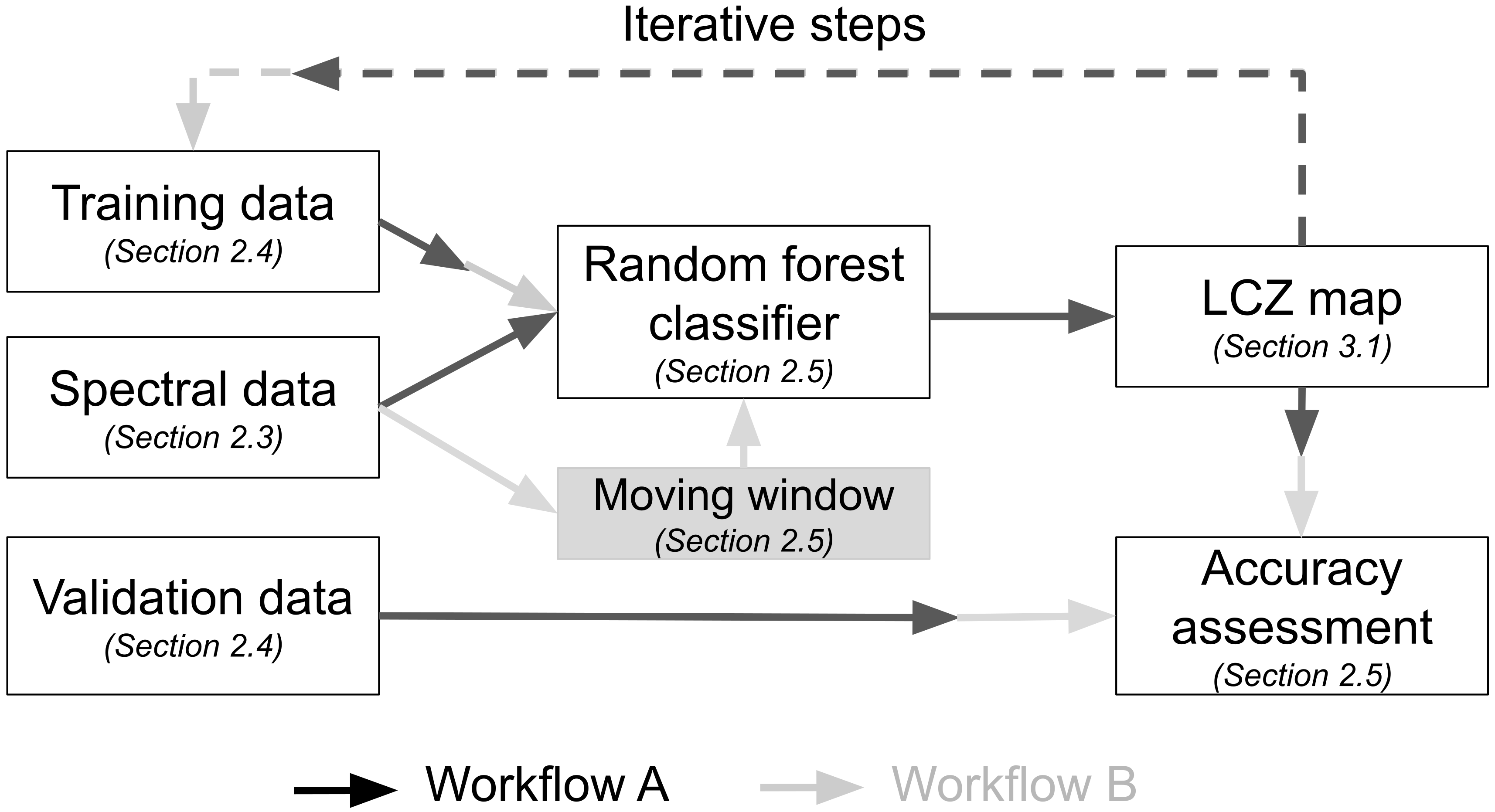
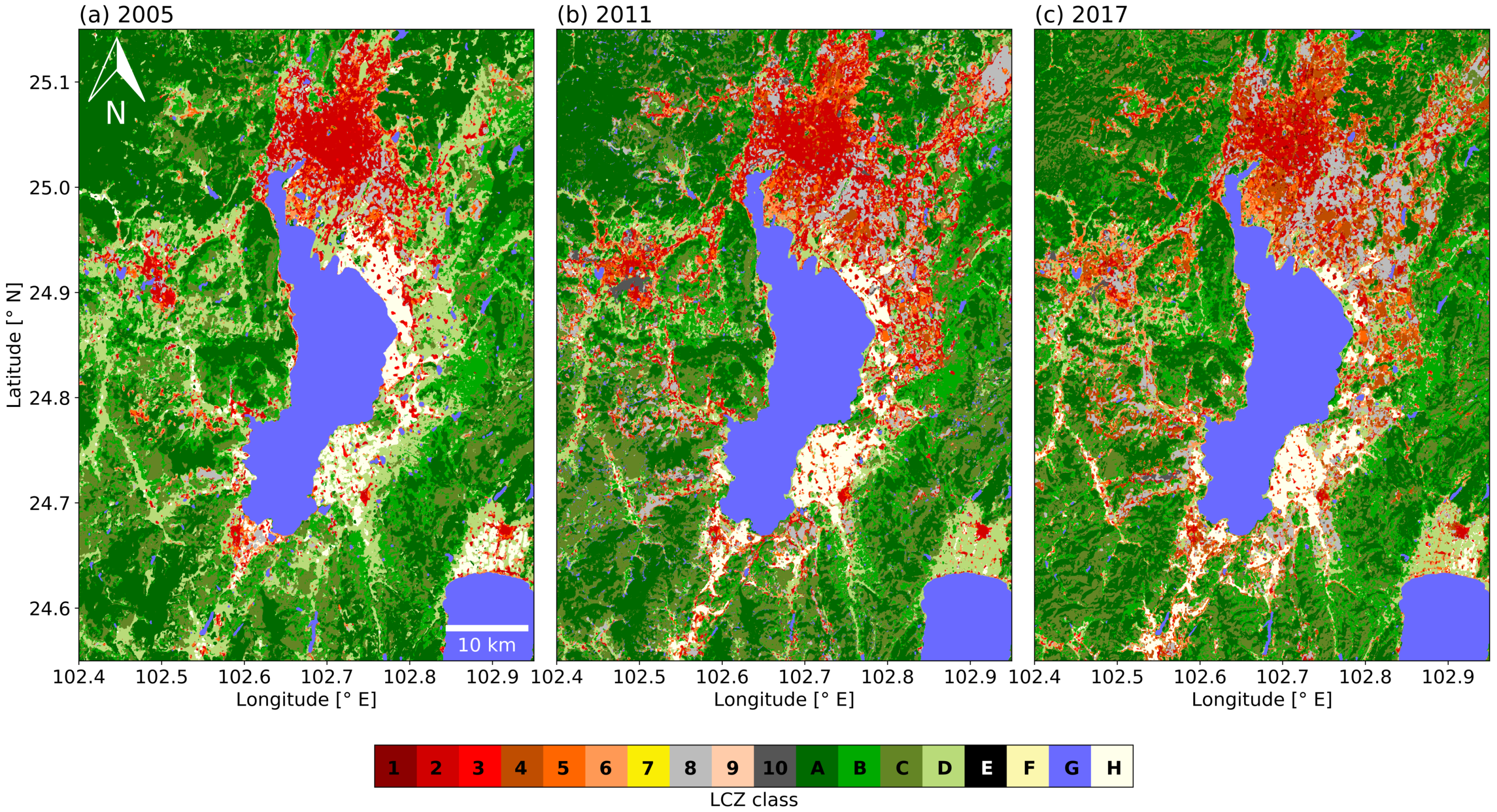

| Mapping Period | Landsat Entity ID | Date |
|---|---|---|
| 2005 | LE07_L1TP_129043_20050406_20170116_01_T1 | 6 April 2005 |
| LE07_L1TP_129043_20050201_20170116_01_T1 | 1 February 2005 | |
| LE07_L1TP_129043_20060103_20170111_01_T1 | 3 January 2006 | |
| 2011 | LE07_L1TP_129043_20110306_20161209_01_T1 | 6 March 2011 |
| LE07_L1TP_129043_20120120_20161203_01_T1 | 20 January 2012 | |
| LE07_L1TP_129043_20111117_20161205_01_T1 | 17 November 2011 | |
| 2017 | LC08_L1TP_129043_20170109_20170311_01_T1 | 1 September 2017 |
| LC08_L1TP_129043_20170314_20170328_01_T1 | 14 March 2017 | |
| LC08_L1TP_129043_20170501_20170515_01_T1 | 1 May 2017 | |
| LC08_L1TP_129043_20170109_20170311_01_T1 | 9 January 2017 |
| Training Polygons | Validation Polygons | |||||
|---|---|---|---|---|---|---|
| 2005 | 2011 | 2017 | 2005 | 2011 | 2017 | |
| LCZ 1 Compact high-rise | 0 | 0 | 10 | 0 | 0 | 4 |
| LCZ 2 Compact mid-rise | 24 | 25 | 27 | 11 | 11 | 13 |
| LCZ 3 Compact low-rise | 15 | 12 | 16 | 5 | 7 | 8 |
| LCZ 4 Open high-rise | 0 | 11 | 28 | 0 | 4 | 12 |
| LCZ 5 Open mid-rise | 13 | 15 | 18 | 7 | 6 | 6 |
| LCZ 6 Open low-rise | 12 | 13 | 19 | 5 | 5 | 8 |
| LCZ 8 Large low-rise | 22 | 13 | 19 | 10 | 6 | 8 |
| LCZ 10 Heavy industry | 0 | 11 | 11 | 0 | 5 | 5 |
| LCZ A Dense trees | 23 | 16 | 16 | 11 | 8 | 8 |
| LCZ B Scattered trees | 15 | 17 | 18 | 7 | 7 | 7 |
| LCZ C Bush, scrub | 19 | 24 | 20 | 8 | 10 | 9 |
| LCZ D Low plants | 25 | 22 | 20 | 12 | 11 | 11 |
| LCZ G Water | 14 | 15 | 15 | 7 | 7 | 7 |
| LCZ H Agricultural greenhouse | 22 | 22 | 21 | 11 | 11 | 11 |
| 2005 (km) | 2011 (km) | 2017 (km) | ||
|---|---|---|---|---|
| Urban LCZ | LCZ 1 | - | - | 13.6 |
| LCZ 2 | 197.5 | 256.6 | 150.6 | |
| LCZ 3 | 50.6 | 34.9 | 30.8 | |
| LCZ 4 | - | 82.6 | 264.7 | |
| LCZ 5 | 60.5 | 73.5 | 105.3 | |
| LCZ 6 | 63.7 | 131.4 | 215.1 | |
| LCZ 8 | 71.8 | 221.2 | 444.5 | |
| LCZ 10 | - | 46.2 | 20.9 | |
| Total urban area | 444.2 | 846.41 | 1245.5 | |
| Natural LCZ | LCZ A | 1402.4 | 1248.0 | 1260.5 |
| LCZ B | 608.2 | 582.3 | 628.6 | |
| LCZ C | 590.4 | 779.1 | 696.6 | |
| LCZ D | 736.1 | 402.6 | 295.4 | |
| LCZ G | 467.3 | 471.0 | 475.4 | |
| LCZ H | 155.3 | 119.2 | 136.2 |
© 2019 by the authors. Licensee MDPI, Basel, Switzerland. This article is an open access article distributed under the terms and conditions of the Creative Commons Attribution (CC BY) license (http://creativecommons.org/licenses/by/4.0/).
Share and Cite
Vandamme, S.; Demuzere, M.; Verdonck, M.-L.; Zhang, Z.; Van Coillie, F. Revealing Kunming’s (China) Historical Urban Planning Policies Through Local Climate Zones. Remote Sens. 2019, 11, 1731. https://doi.org/10.3390/rs11141731
Vandamme S, Demuzere M, Verdonck M-L, Zhang Z, Van Coillie F. Revealing Kunming’s (China) Historical Urban Planning Policies Through Local Climate Zones. Remote Sensing. 2019; 11(14):1731. https://doi.org/10.3390/rs11141731
Chicago/Turabian StyleVandamme, Stéphanie, Matthias Demuzere, Marie-Leen Verdonck, Zhiming Zhang, and Frieke Van Coillie. 2019. "Revealing Kunming’s (China) Historical Urban Planning Policies Through Local Climate Zones" Remote Sensing 11, no. 14: 1731. https://doi.org/10.3390/rs11141731
APA StyleVandamme, S., Demuzere, M., Verdonck, M.-L., Zhang, Z., & Van Coillie, F. (2019). Revealing Kunming’s (China) Historical Urban Planning Policies Through Local Climate Zones. Remote Sensing, 11(14), 1731. https://doi.org/10.3390/rs11141731







